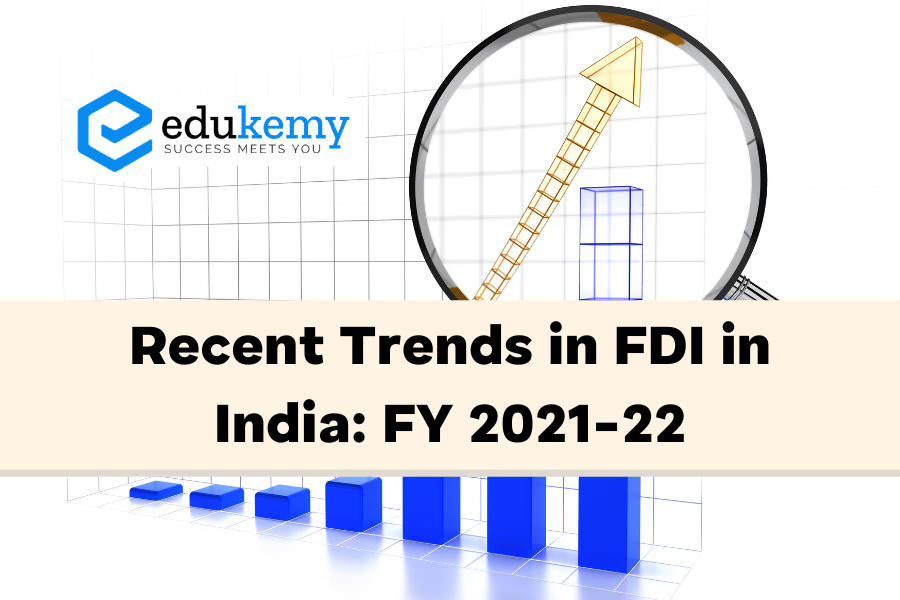
In fiscal year 2021-22, India witnessed a notable surge in Foreign Direct Investment (FDI), reflecting the country’s growing prominence as a favored destination for international capital. Amidst global economic uncertainties, India stood resilient, attracting substantial investments across diverse sectors. This period marked a continuation of the upward trajectory in FDI inflows, with several key trends emerging that underscored the evolving dynamics of India’s investment landscape. From advancements in digital infrastructure to policy reforms aimed at enhancing ease of doing business, the year showcased India’s proactive approach in attracting foreign investors. Analyzing the recent trends in FDI unveils a nuanced understanding of the factors driving investment decisions and highlights the opportunities and challenges shaping India’s economic future.
Contents
- 1 Recent Trends in FDI in India: FY 2021-22
- 2 FAQs
- 2.1 Q1: What were the trends in Foreign Direct Investment (FDI) inflows in India during FY 2021-22?
- 2.2 Q2: Which sectors attracted the highest FDI inflows in India during FY 2021-22?
- 2.3 Q3: What factors contributed to the increase in FDI inflows in India during FY 2021-22?
- 2.4 Q4: Did FDI inflows in India face any challenges during FY 2021-22?
- 2.5 Q5: What are the prospects for FDI inflows in India in the coming years based on the trends observed in FY 2021-22?
- 3 In case you still have your doubts, contact us on 9811333901.
Recent Trends in FDI in India: FY 2021-22
Overview:
- Record-High FDI: In the Financial Year 2021-22, India witnessed its highest-ever Foreign Direct Investment (FDI) figure, reaching $83.57 billion.
- Post-Covid Growth: FDI showed a significant increase of around 22% post-Covid, from 2020 to 2022, amounting to $171.84 billion. This represents a notable rise from the pre-Covid inflows of $141.10 billion reported from 2018 to 2020.
Sector-wise Distribution:
- Top Recipient Sectors:
- Computer Software and Hardware: Emerged as the leading sector receiving FDI equity inflows, capturing approximately 25% of the total.
- Services and Automobile Sectors: Followed closely with each sector securing a 12% share.
- Manufacturing Sector Growth: FDI equity inflows in the manufacturing sector experienced a remarkable increase of 76% in FY22, reflecting growing investor confidence in India’s manufacturing capabilities.
Geographical Distribution:
- State-specific Data:
- Major Recipient States: Karnataka led with 53% of FDI equity inflows, followed by Delhi and Maharashtra, both at 17%.
- Country-specific Data:
- Top Investor Countries:
- Singapore: Accounted for the highest share at 27% of total FDI.
- United States: Secured the second position with an 18% share.
- Mauritius: Ranked third, contributing 16% to the total FDI.
- Top Investor Countries:
Significance and Growth Trajectory:
- Emerging Manufacturing Hub: India is rapidly establishing itself as a preferred destination for foreign investments in the manufacturing sector.
- Remarkable Growth: The country’s foreign investment inflows have witnessed a substantial increase, growing 20-fold since the financial year 2003-04, when it recorded a mere $4.3 billion.
Implications:
- Positive Economic Indicator: The surge in FDI reflects a positive economic environment, showcasing investor confidence in India’s potential across various sectors.
- Manufacturing Boost: The significant rise in manufacturing sector FDI signifies India’s increasing attractiveness as a manufacturing hub.
Conclusion: India’s record-high FDI in FY 2021-22, particularly in the manufacturing sector, highlights the country’s growing prominence as an attractive investment destination. The sustained increase in foreign investment underscores positive economic indicators and sets the stage for continued growth and development.
FAQs
Q1: What were the trends in Foreign Direct Investment (FDI) inflows in India during FY 2021-22?
A1: FDI inflows into India witnessed a significant surge during FY 2021-22, reaching record highs despite the global economic challenges. The inflows were primarily driven by investments in digital technology, telecommunications, and manufacturing sectors.
Q2: Which sectors attracted the highest FDI inflows in India during FY 2021-22?
A2: The digital technology sector emerged as a frontrunner, attracting substantial FDI inflows during FY 2021-22. Additionally, sectors such as telecommunications, manufacturing, renewable energy, and e-commerce also garnered significant foreign investment.
Q3: What factors contributed to the increase in FDI inflows in India during FY 2021-22?
A3: Several factors contributed to the rise in FDI inflows, including the government’s efforts to ease regulations and promote investment-friendly policies. The implementation of structural reforms, the country’s large consumer base, and its strategic geographical location further bolstered investor confidence.
Q4: Did FDI inflows in India face any challenges during FY 2021-22?
A4: While FDI inflows surged overall, certain challenges persisted, including geopolitical uncertainties, global economic volatility, and intermittent disruptions due to the COVID-19 pandemic. However, India’s resilience and proactive policy measures helped mitigate these challenges to a large extent.
Q5: What are the prospects for FDI inflows in India in the coming years based on the trends observed in FY 2021-22?
A5: The outlook for FDI inflows in India remains positive, with continued momentum expected in key sectors such as digital technology, manufacturing, and renewable energy. The government’s commitment to further liberalize policies and enhance the ease of doing business is likely to attract even more foreign investment in the foreseeable future.
In case you still have your doubts, contact us on 9811333901.
For UPSC Prelims Resources, Click here
For Daily Updates and Study Material:
Join our Telegram Channel – Edukemy for IAS
- 1. Learn through Videos – here
- 2. Be Exam Ready by Practicing Daily MCQs – here
- 3. Daily Newsletter – Get all your Current Affairs Covered – here
- 4. Mains Answer Writing Practice – here

